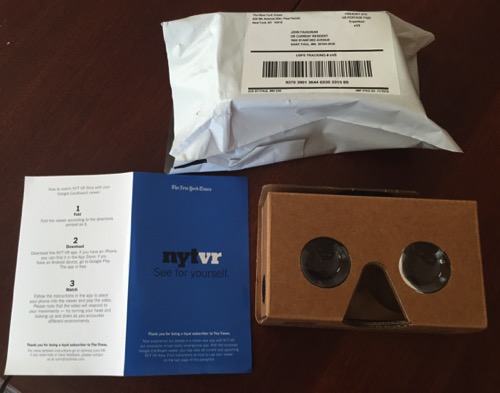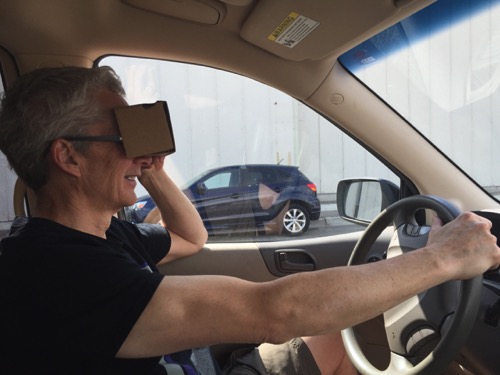This came in the mail today.

I assume every subscriber got one, but I’ve not heard much chatter. The return address had Attn: Paul Ferrall on it; that seemed a bit curious. (Update: looks like they sent them out last Nov to Sunday print subscribers. Didn’t get much buzz!)
It’s a Google cardboard viewer of course ($15 retail). The NYT has launched a Virtual Reality channel; there are iOS as well as Android apps.
It was my first experience with Google Tech. I very clearly remember the last time I had this feeling; it was using a View-Master back when they they provided very high quality stereo images. There was a young woman sitting on the edge of a tall cliff with a boat far below.
The streaming wasn’t working today, but downloading was fine. Gigabit broadband would be handy.
The whale/echo video is the most amazing. I elbowed my daughter spinning about. First VR injury in our family.
It’s easy to see where this will go next …

1 comment:
I have a plastic version (a plastic cardboard?) but never got a feeling of motion with any of the videos. If you search for cardboard demos, there are a few good ones out there but most of the stuff for it left me wondering if it was more than a short interest item.
The quality of the lenses is important. In my case I should have gotten one that had adjustable pupil spacing and focus.
You can download the Cardboard Camera app that lets you take a 360 degree photo that lets the viewer look around. Even though it is taken without real depth data, it feels very 3D. I couldn't find a way to copy the photos so that you can share them with friends. There is some public site but I may not want all my pictures there. I doubt that anyone else wants to see my test photo of the electrical lab. This could be quite the thing for vacation photos.
We are working with virtual reality at work with several particular uses in mind. Currently are using Oculus Rift with software and extra sensor that will put virtual arms and hands in the image that mimic your movements. In addition to allowing people to "see" designs that haven't been built, it is good for checking that trying to press a control panel button requires reaching around a control joystick or what the operator's sight lines are. Also being considered for making training videos for the workers assembling the equipment.
One particular use I can see for the Cardboard is having the VR software output the stereo pair to the computer monitor and then setting up a Skype for Business meeting to display it on the phone in the cardboard. A person at a remote location would get an immersive 3D copy of the view from the VR system. Now that we have the hands working, the VR operator could explain items verbally and point to them in the VR world.
Yes, I have knocked my coffee off my desk while swiveling in my chair with the Cardboard. Full VR is even more risky with people running into the computer or walls unless you have a person watching them to guide them away from the real reality items. One of the newer VR goggle systems has a way to set up virtual fences that appear so that people don't run into things.
Post a Comment